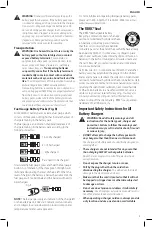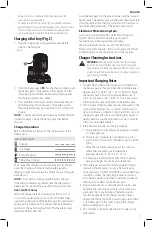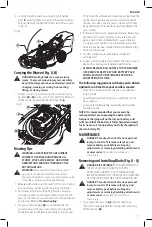
English
4
•
Store Idle Lawn Mower Indoors –
When not in use,
lawn mower should be stored in an indoor dry and locked-
up place – out of reach of children. Remove safety key and
battery pack.
•
Maintain Lawn Mower With Care –
Keep cutting edges
sharp and clean for best and safest performance.
•
Keep guards in place and in working order.
•
Keep blades sharp
.
•
Keep hands and feet away from cutting area.
•
Objects struck by the lawn mower blade can cause
severe injuries to persons.
The lawn should always
be carefully examined and cleared of all objects prior to
each mowing.
•
If lawn mower strikes a foreign object, follow
these steps:
1. Stop lawn mower. Release the bail handle.
2. Remove battery pack and safety key.
3. Inspect for damage.
4. Repair any damage before restarting and
operating the lawn mower.
•
Use identical replacement blades only.
SAVE THESE INSTRUCTIONS
Additional Safety Warnings
WARNING:
Some dust created by this product
contains chemicals known to the State of California to
cause cancer, birth defects or other reproductive harm.
Some examples of these chemicals are:
• compounds in fertilizers
• compounds in insecticides, herbicides and
pesticides
• arsenic and chromium from chemically treated
lumber
To reduce your exposure to these chemicals, wear approved
safety equipment such as dust masks that are specially
designed to filter out microscopic particles.The label on your
tool may include the following symbols. The symbols and their
definitions are as follows:
V ......................... volts
Hz .......................hertz
min .....................minutes
or DC ......direct current
...................... Class I Construction
(grounded)
…/min ..............per minute
BPM ....................beats per minute
IPM .....................impacts per minute
RPM .................... revolutions per
minute
sfpm ................... surface feet per
minute
SPM ....................strokes per minute
A .........................amperes
W ........................watts
or AC ...........alternating current
or AC/DC .... alternating or
direct current
...................... Class II
Construction
(double insulated)
no .......................no load speed
n .........................rated speed
......................earthing terminal
.....................safety alert symbol
.....................visible radiation
..................... wear respiratory
protection
..................... wear eye
protection
..................... wear hearing
protection
..................... read all
documentation
BATTERY AND CHARGERS
The battery pack is not fully charged out of the carton.
Before using the battery pack and charger, read the
safety instructions below and then follow charging
procedures outlined. When ordering replacement battery
pack, be sure to include the catalog number and voltage.
Your tool uses a
D
e
WALT
charger. Be sure to read all safety
instructions before using your charger. Consult the chart
at the end of this manual for compatibility of chargers and
battery pack.
READ ALL INSTRUCTIONS
Important Safety Instructions for All
Battery Packs
WARNING: Read all safety warnings and all
instructions for the battery pack, charger and
power tool. Failure to follow the warnings and
instructions may result in electric shock, fire and/
or serious injury.
•
Do not charge or use the battery pack in explosive
atmospheres, such as in the presence of flammable
liquids, gases or dust.
Inserting or removing the battery
pack from the charger may ignite the dust or fumes.
•
NEVER force the battery pack into the charger. DO
NOT modify the battery pack in any way to fit into
a non-compatible charger as battery pack may
rupture causing serious personal injury.
Consult
the chart at the end of this manual for compatibility of
batteries and chargers.
• Charge the battery packs only in designated
D
e
WALT
chargers.
•
DO NOT
splash or immerse in water or other liquids.
•
Do not store or use the tool and battery pack in
locations where the temperature may reach or
exceed 104 °F (40 °C) (such as outside sheds or metal
buildings in summer).
For best life store battery packs in
a cool, dry location.
NOTE: Do not store the battery packs in a tool with
the trigger switch locked on. Never tape the trigger
switch in the ON position.
•
Do not incinerate the battery pack even if it is
severely damaged or is completely worn out.
The
battery pack can explode in a fire. Toxic fumes and
materials are created when lithium ion battery packs
are burned.
•
If battery contents come into contact with the skin,
immediately wash area with mild soap and water.
If
battery liquid gets into the eye, rinse water over the open
eye for 15 minutes or until irritation ceases. If medical
attention is needed, the battery electrolyte is composed of
a mixture of liquid organic carbonates and lithium salts.
•
Contents of opened battery cells may cause
respiratory irritation.
Provide fresh air. If symptoms
persist, seek medical attention.
WARNING:
Burn hazard. Battery liquid may be
flammable if exposed to spark or flame.







































